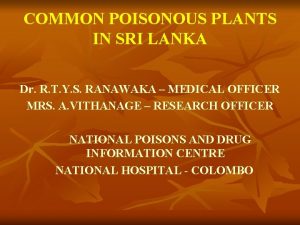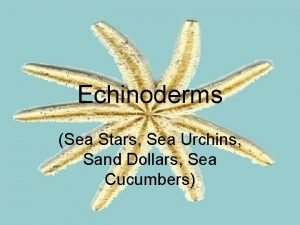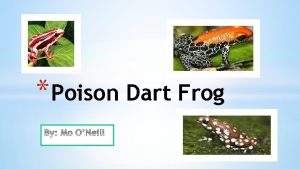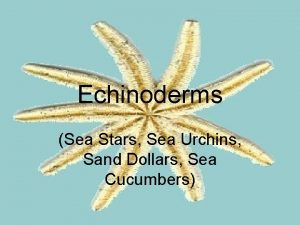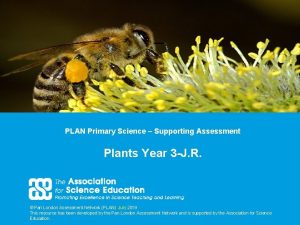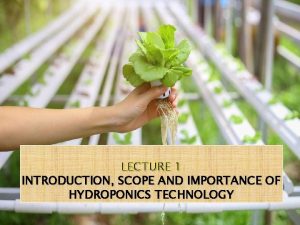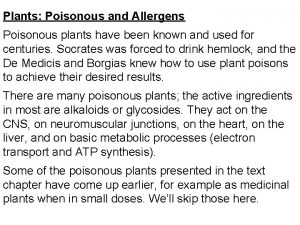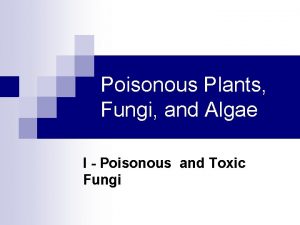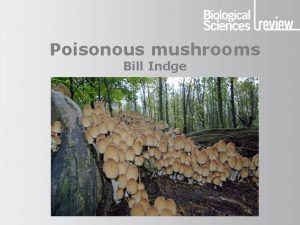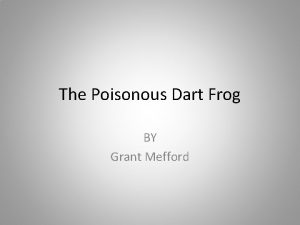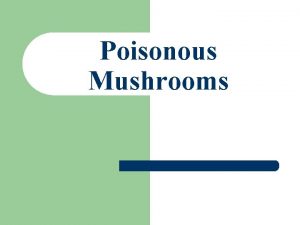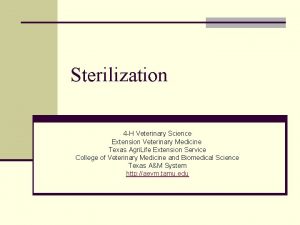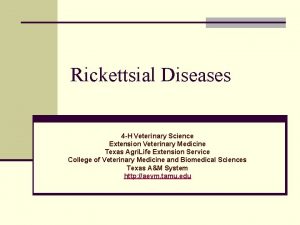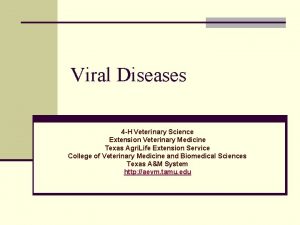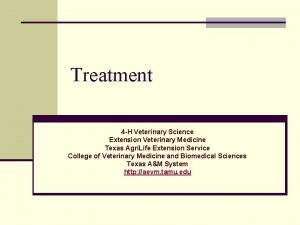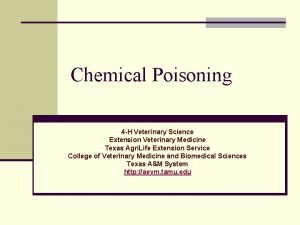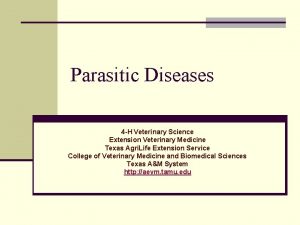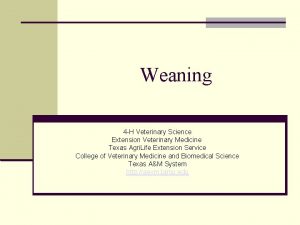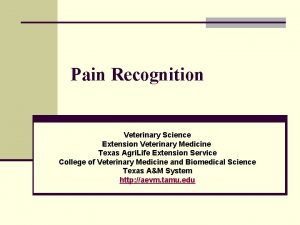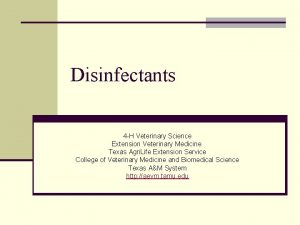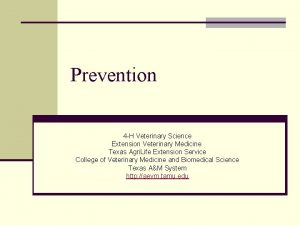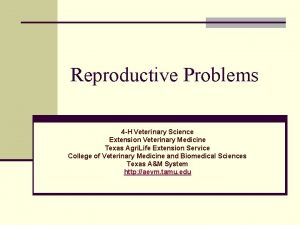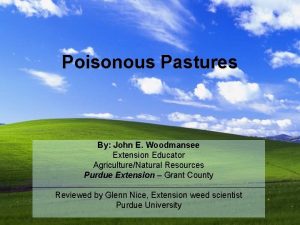Poisonous Plants 4 H Veterinary Science Extension Veterinary




























- Slides: 28

Poisonous Plants 4 -H Veterinary Science Extension Veterinary Medicine Texas Agri. Life Extension Service College of Veterinary Medicine and Biomedical Sciences Texas A&M System http: //aevm. tamu. edu

Objectives n Discuss the factors that cause an animal to consume poisonous plants n Describe the signs of oak poisoning n List and recognize plants that contain cyanide n Describe signs of cyanide poisoning n List and recognize plants that contain excessive nitrate n Describe signs of nitrate poisoning n Discuss laboratory methods for diagnosing plant poisoning in animals

Review n Non-Infectious Diseases n Nutritional Diseases n Reproductive Problems n Chemical Poisoning n Toxicity of Insecticides n Poisonous Plants n Miscellaneous Plants

Poisonous Plants n Why plants n Decoration n Ground cover n Hay n Etc n Problem n May be poisonous n Certain stage of growth § Seasonal n Large quantities

n Plants area specific n Temperature n Rainfall n Soil n Terrain n Know the plants in your area

n To help prevent problem n Identify poisonous plants n Remove animals n Remove plants n Spraying n Mowing n Remove clippings and wilted leaves n If suspect poisoning n Move animals n Call veterinarian

n Plant identification n Leaves n Seeds n Flowers n Root system n Stems

Detection of Poisonous Plants n Hard to determine if illness or death due to poisonous plants Field observation n Laboratory diagnosis n n Blood samples Urine samples Stomach contents

Examples n Oaks n n n Contain gallotannin Affects kidneys Poison n Leaves § Seasonal § Spring § Early growth § Buds § palatable n Acorns § Seasonal § Fall § Green acorns § Abundant § Brown/mature acorns are ok

n Symptoms n n Weight loss Depression Blood tinged nasal discharge Diarrhea § Mucous § Blood n n Increased water consumption Increased urination

n Treatment n n Prevention n Remove animals from area Graze on acorn-free pastures Return only when acorns brown Feed calcium hydroxide as supplement Monitor acorn and leave conditions If severe kidney damage - death

n Plants with cyanide n May form cyanide n Rapid poisoning n Rapid death n Ruminants are more susceptible n Examples n n Grain sorghums Johnson grass Sudan grass Wild black cherry tree

n When occurs n n Drought Frost Have elevated concentrations n Dissipates in hay n n Affects n Blocks the use of oxygen by cells

n Symptoms n n n n Increase breathing rate Excited Rapid breathing Bright red mucous membranes Labored breathing Muscle trembles and spasms Large amounts consumed § Stagger § Fall § Convulsions

n Treatment n n n None = death Remove animals Prognosis n If survive 2 hours possibility of living

Excessive Nitrates n Plants can accumulate nitrate compounds n High concentrations not usually present in plants n Conditions n Excessive nitrate fertilizer § Pond runoff n n Unusual fertilizer Unusual conditions § Drought § Rain after a drought n Rapid growth

n Ruminants are more susceptible n n n Rumen flora convert to ammonia Nitrite is intermediate step (~10 times more toxic) Interferes with the bloods ability to carry oxygen to tissue

n Crops with high nitrate concentrations n Cereal grasses n n n Oats Millet Rye Corn n Sunflower n sorghums n

n Weeds with high nitrate concentrations n Pigweed n Lamb’s quarter n Thistle n Jimson weed n Fireweed n Smartweed n Dock n Johnson grass

n Symptoms n Occur quickly or after several days n Weakness n Trembling n Staggering n Rapid breathing n Collapsing n Brownish-blue membranes (mouth and nostrils)

n Treatment n Work with a veterinarian

n Dallis Grass n Ergot fungus in seed heads n n Advanced stages have toxin Affects the CNS Does not affect horses See in late summer

n Symptoms n n Treatment n n Nervousness Excitable Trembling/staggering walk Remove animals Prevention n Mow down the seed heads

n Coffee Senna n Affects muscle n Found along roadsides n Not eaten if possible

n Symptoms n n n n Weakness Unable to stand Coffee colored urine Diarrhea Ataxic Afebrile Alter up until death Treatment n None known

n Oleander n Common ornamental plant n Tree like n Affects the heart n Small amounts are fatal n Has a bitter taste n Species n All

n n Symptoms n Appear 4 -12 hours after eating n Depression n Vomiting n Diarrhea n Increased pulse rate n Weakness n Trembling n Convulsions n Coma n Death Treatment n None

Resources n Toxic Plants of Texas n https: //agrilifebookstore. org/ n $25
 Goda kaduru tree
Goda kaduru tree Brand leveraging strategies
Brand leveraging strategies Echinodermata segmentation
Echinodermata segmentation Conclusion on bhopal gas tragedy
Conclusion on bhopal gas tragedy Classification of poisonous snakes
Classification of poisonous snakes Poison dart frog niche
Poison dart frog niche Sand dollar internal anatomy
Sand dollar internal anatomy Poisonous gas leaked in bhopal gas tragedy
Poisonous gas leaked in bhopal gas tragedy How to use a urinal without a zipper
How to use a urinal without a zipper Poisonous coral snake
Poisonous coral snake Allelic diversity
Allelic diversity Platypus poison
Platypus poison Poisonous
Poisonous Household safety symbols
Household safety symbols Science science science
Science science science Nonvascular plant
Nonvascular plant Non vascular vs vascular plants
Non vascular vs vascular plants Flowering and non flowering plants similarities
Flowering and non flowering plants similarities C3 plant
C3 plant Hsc science extension
Hsc science extension Hsc science extension
Hsc science extension Plants year 3 science
Plants year 3 science Hydroponics is the science of growing terrestrial plants in
Hydroponics is the science of growing terrestrial plants in Social science vs natural science
Social science vs natural science Three branches of science
Three branches of science Natural and physical science
Natural and physical science Applied science vs pure science
Applied science vs pure science Rapid change
Rapid change Science fusion online
Science fusion online
